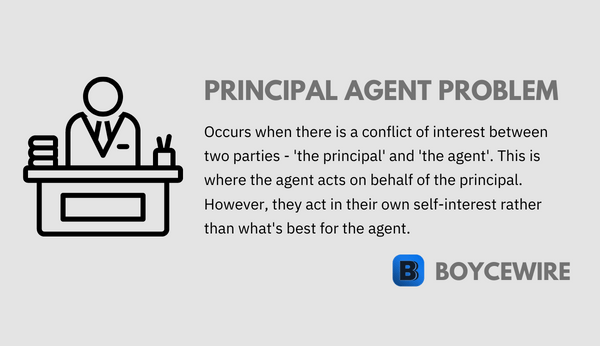Principal Agent Problem: Definition, Examples & Solutions

What is the Principal Agent Problem?
The Principal Agent Problem is where there is a conflict of interest between ‘the principal’, and ‘the agent’. In this case, the principal refers to the person who delegates authority and responsibility to the agent. So the agent acts on behalf of the principal. The problem then arises when the interests of the agent and the principal do not align.
For instance, the CEO of a big firm is in charge of running it. They are the agent that acts on behalf of the principal – the shareholders. The principal agent problem arises when the interests of the CEO do not align with the shareholders.
If we look at company acquisitions, shareholders generally have a right to vote. However, Kraft’s purchase of Cadburys in 2010 avoided doing so by restructuring the acquisition through an option made available in US law.
What happened was the board of directors bypassed the shareholders to get the deal passed. In fact, one of the companies leading investors, Warren Buffett, said it was a ‘bad deal’ and would have voted against it given the chance.
Key Points
- The Principal Agent Problem is where there is a conflict of interest between the Principal, and the agent (who works on behalf of the principal).
- The Principal Agent Problem occurs frequently, ranging from management and workers, to government and its voters.
- Resolving the problem requires re-alignment of incentives – although sometimes this is not possible.
Examples of Principal Agent Problem
1. Online Grocery Shopping
Online grocery shopping has become extremely popular in Europe over the course of the last decade. The concept is rather simple. A store employee acts as the agent, and goes around picking up items ordered by the customer, or the principal.

The two parties do not align in the fact that store employees are encouraged to pick as many items as possible. However, the customers interests lie in obtaining foods with long dates and items that are fresh. Often, we find that upon delivery, some goods run out of date the next day.
2. Salespeople and the Customer
The majority of sales jobs are based on commission, so a salesperson is incentivised to make a sale. However, higher ticket items mean higher commissions. So they are also incentivised to make bigger sales.
In turn, we often see a salesperson going beyond the customers budget in a bid to get them to spend more. For instance, the customer may want to buy a car for $20,000. However, salespeople often show the customer more expensive cars in the hope they will fall in love with one at a higher price.
Another example can be seen in wedding dress shopping. For such a big day, the brides budget can increase rapidly if they fall in love with a specific dress. So it is in the interest of the salesperson to get as high of a sale as they can.
In turn, they are incentivised to get the bride to fall in love with a dress outside of her budget. By contrast, the bride is usually restricted by a budget and the need to keep costs down. Often, psychological techniques are used in order to push the buyer up into higher price brackets so the salesperson makes more.
3. Government and the Public
By its very definition, the government is meant to represent the will of the people. Those who are in power are the agents, whilst the voters are the principals. They are acting on behalf of the voters and the public.
The principal agent problem occurs when those in government do not carry out the will of the people and fail to represent them effectively. On occasion, this happens because the two parties interests do not align.

For instance, the UK government introduced the ‘Poll Tax’, essentially a yearly tax on home owners, in 1990. It was met with fierce resistance including a number of riots in the streets. We can also move this forward to 2019 and 2020 which saw violent protests against the government in both France and Hong Kong.
In France for instance, President Macron has averaged around a 60 percent disapproval rating during his tenure. One of the main points of dispute was abolishment of a wealth tax on the rich. It was seen as an elitist move by the President and one that was not popular among the public.
4. Tradesmen and Women
In trades such as engineering, plumbing, gas engineering, and electrics, they can all create a principal agent problem. This is because the tradesman or woman may have a direct conflict of interest with the customer.
In this example, the tradesman or woman is the ‘agent’, whilst the customer is the ‘principle’. It is in the interest of the agent to make money from the customer. If we also consider the fact that the customer does not necessarily know what needs to be fixed, it can lead to greater costs that are not needed.
This comes under asymmetrical information as the customer knows less than the agent. In turn, the customer may end up paying for work that they don’t need.
Solutions to the Principal Agent Problem
The principal agent problem arises when the interests of each party are not aligned. So how can this be solved? Well it depends on the situation, but the solution lies in trying to align their interests.
1. Directors and Shareholders
If we take the example of the company directors and shareholders. How do we align the interests of both parties? Well one of the most common ways we see today is awarding directors with shares in the firm. They then become a shareholder themselves, which means their interests become more in line with the shareholders.
2. Management and Workers
We also have the issue lower down the management chain between workers and managers. Not all workers necessarily want to work as hard as their managers would like. So to prevent workers from slacking, management would have to implement some form of monitoring the employees. Or perhaps, blocking internet sites such as Facebook and Twitter which are known to drain productivity.
3. Government and Voters
The interest gap between the government and voters would seem simple. If government doesn’t do what the people want, they will vote them out. Well that is relatively straight forward, but most nations have a 4 to 5 year election cycle. So governments can push through unpopular policies early on and implement favourable ones come election time.

One potential solution would be to reduce the election cycle. Or, alternatively, implement a US style system by which there is a second level of government via the Senate or Congress. This additional level would be able to block the other party from passing any meaningful legislation.
4. Long Term Stock Commitment
In 2013, Apple introduced a new initiative that requires senior executives to hold at least 3 times their annual salary in shares. This then has to be kept for a minimum of five years. In turn, it encourages new executives to align their long-term interests with that of the company.
FAQs on the Principal Agent Problem
The principal-agent problem can be resolved by aligning the interests of both parties. As the agent that works on behalf of the principal may have different incentives, it is important to bring these in line as much as possible. For example, a tradesman might have a reputation to hold where he gets most of his business through referrals.
A principal-agent example is that of the shareholders and the directors.
The principal refers to the individual that delegates authority and responsibility to the agent. So the agent acts on behalf of the principal. The problem then arises where the interests of the agent and the principal do not align.
About Paul
Paul Boyce is an economics editor with over 10 years experience in the industry. Currently working as a consultant within the financial services sector, Paul is the CEO and chief editor of BoyceWire. He has written publications for FEE, the Mises Institute, and many others.

Further Reading
 Bull Market - A bull market is a financial market where prices of securities are generally rising, indicating positive investor sentiment and a…
Bull Market - A bull market is a financial market where prices of securities are generally rising, indicating positive investor sentiment and a…  Importance of Entrepreneurship - Entrepreneurship is the act by an individual to start and develop their own business.
Importance of Entrepreneurship - Entrepreneurship is the act by an individual to start and develop their own business.  Cross Price Elasticity of Demand: Types & Examples - Cross Price Elasticity of Demand (XED) measures the relationship between two goods when the price of one changes.
Cross Price Elasticity of Demand: Types & Examples - Cross Price Elasticity of Demand (XED) measures the relationship between two goods when the price of one changes. 